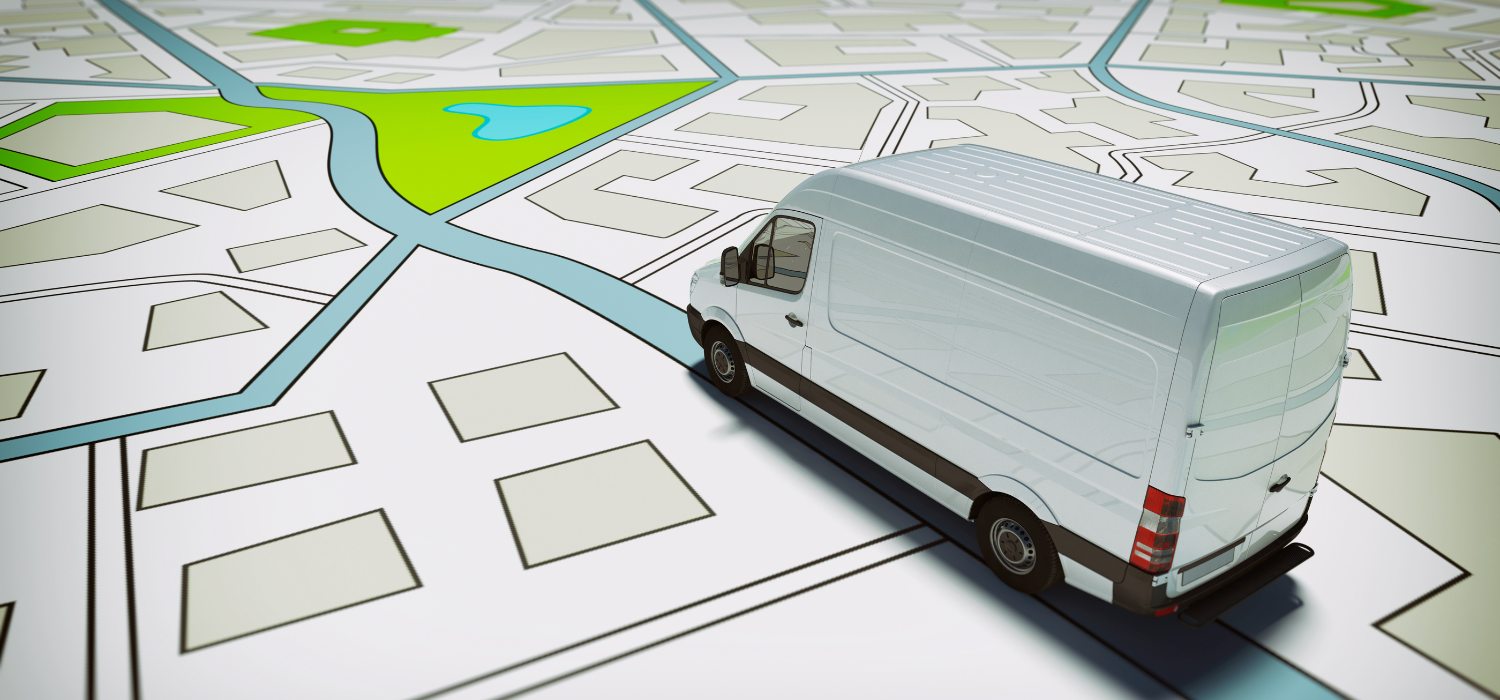Imagine a courier driving a van in the middle of a city centre. He has to make an average of ten deliveries in an hour, avoiding LTZs, finding parking close to the delivery point, perhaps dodging a sudden demonstration. Can he manage it? Yes, but only if his transport management system – the so-called TMS – has access to intelligent digital maps, updated in real time and enriched with strategic information such as logistical points of interest.
Welcome to the world of Big Data applied to logistics, where advanced cartography and proximity data allow TMS software to guide couriers and transporters with surgical precision. Providers such as HERE Technologies or TomTom are already playing a key role in this scenario, collecting billions of data points every day to feed ever more detailed and functional transport maps.
In this article, we will explore how geospatial data, in particular POIs (Points of Interest), are transforming urban logistics and beyond, optimising time, routes and costs for carriers, logistics operators and eCommerce.
TMS and digital maps: the evolution of logistics planning
Let us start by clarifying a very important point: today, TMSs are much more than a simple planner. A TMS is in fact a software system for managing shipments, carriers and delivery tracking that integrates with intelligent maps to offer predictive functionality as well: not only where to go, but also when and why, based on real-time traffic conditions.
The importance of maps for road transport
Today, it is no longer enough to know where to go. In modern, efficient logistics, how you get there makes all the difference. That is why digital maps do not just represent roads and junctions: they have become dynamic tools, capable of indicating the best route according to vehicle type, time of day, traffic conditions and the nature of the goods transported. In other words, they also include optimised routes and information on logistical POIs such as car parks, service stations and loading zones.
This data is crucial for those working in road transport, such as couriers for last-mile deliveries, as this level of detail can mean avoiding costly detours, downtime and even fines. In a word: efficiency.
Map providers: the market leaders and their technologies
In the global landscape of digital cartography for logistics, there are a number of leading players, such as HERE Technologies and TomTom, with their long experience in the field and deep specialisation in routing for commercial vehicles. Alongside them, however, there are also other suppliers, such as Google Maps, OpenStreetMap and Mapbox.
HERE Technologies is a pioneer in GPS navigation. Today it manages a database of more than 143 million POIs in 196 countries, with daily updated information on opening hours, available services, payment methods and accessibility of mapped locations.
TomTom, known for producing satellite navigation systems for the general public, has in recent years dedicated itself to developing one of the most advanced geolocation platforms in the world. Its maps include an extensive network of geolocalised POIs: there are approximately 642,000 petrol stations, 92,000 car parks, 6 million restaurants and 1 million hotels, covering 188 countries.
Both providers adopt advanced data collection systems via connected vehicles, artificial intelligence, fleet tracking and crowdsourced contributions. In this way, they are able to continuously update their maps not only from a roadside perspective, but also with respect to the most relevant points of interest for professional transport.
Where does the data come from
At this point the question is inevitable: where does the data that feed and update the digital maps used in TMS come from? Who provides, and more importantly how is it collected, the enormous amount of information that allows a routing system to know where the LTZ entrances, truck parking spaces or the correct access to a warehouse are?
There are many sources, but they fall into three main categories.
Fleet data: data coming straight from the road
Every day, millions of connected vehicles transmit real-time data on their location, speed, traffic conditions, stops and detours. This ‘collective intelligence’ – also known as probe data – is collected by providers and used to constantly update road conditions and optimise routes suggested by TMSs.
Crowdsourcing: community intelligence
In addition to data from fleets, these platforms also exploit direct user input.
HERE Map Creator, for example, allows drivers to report changes to the road layout, such as new roundabouts, construction sites, one-way streets or points of interest. TomTom has also built a global network of partners and volunteers who provide up to 2 billion map updates per month, resulting in a constantly evolving map.
External partners: the value of vertical data
Finally, a key part of the information comes from specialised third parties, such as public authorities, infrastructure managers, mobile apps and geospatial content providers. A well-known example is Foursquare, which provides detailed data on POIs such as restaurants, shops and petrol stations, enriched with photos, reviews and opening hours. Or East View Geospatial, a partner for the provision of high-precision topographic and logistical datasets.
POI and routing: the data that make the difference
What are POIs and why they are crucial for TMSs
When it comes to digital maps in logistics, as we anticipated, it is not just about roads and directions. The real added value lies in POIs, which stand for Points of Interest, i.e. geolocalised places with precise coordinates (latitude and longitude) and enriched with contextual information.
For tourism they can be restaurants or museums, but in the world of logistics, POIs become fundamental operational tools. We are talking about distribution centres, car parks equipped for HGVs, loading and unloading points, dedicated truck service stations, lockers, secondary entrances to points of sale, customs gates, or restricted traffic zones (ZTL).
These data are indispensable for constructing reliable routes. A courier who receives an address without knowing where to stop the vehicle, or which side of the warehouse to access, risks wasting time, fines or delays in deliveries. In a world where punctuality is often a critical KPI, it is evident how POI makes a difference.
Intelligent and predictive routing: the value of real-time data
Integrating POIs within a TMS means turning a simple route on a map into a dynamic and intelligent routing strategy. It is not just a matter of finding the shortest route, but of building a truly sustainable and efficient route, taking into account all operational variables.
Thanks to POIs, an advanced TMS is therefore able to:
- Calculate realistic routes, including mandatory stops, time limits and vehicle characteristics;
- Avoid prohibited or restricted areas (LTZs, narrow roads, bridges with weight restrictions);
- Optimise schedules and loads, managing deliveries according to recipients’ time windows or unloading times;
- Reduce costs and environmental impact by avoiding unnecessary journeys, downtime and detours.
In short, POIs make the TMS a predictive and proactive tool, able to adapt in real time to traffic, weather conditions or route changes. And for those working in urban transport or the last mile, every second saved can make the difference between an on-time delivery and an unsatisfied customer.
Concrete benefits for the supply chain
Efficiency, sustainability and savings
The integration of POIs into TMSs is not just a technological evolution: it is an operational paradigm shift.
By using up-to-date and contextual geospatial data, transport companies gain a concrete competitive advantage, visible at every stage of the delivery cycle. The benefits are numerous and measurable, for example:
- Fewer kilometres travelled and, consequently, lower fuel consumption;
- Reduced waiting times, thanks to better planning of stops and loading/unloading times;
- Cutting CO₂ emissions, an increasingly central element in companies’ environmental KPIs and ESG balance sheets;
- Lowering operating costs and improving the customer experience through more accurate delivery times and more predictable logistics.
For companies operating in eCommerce or city logistics, these benefits translate into a smoother, more sustainable and economically efficient supply chain.
Let’s imagine an everyday scene: a courier company tasked with making five deliveries in the centre of Milan during rush hour. Without the help of an advanced system, he runs the risk of finding himself blocked by ZTL lanes, without knowing where to park and forced to make endless rounds.
Now imagine the same scenario, but with a TMS using maps enriched with POI data. In a matter of seconds, the system is able to generate a route that avoids restricted traffic areas, suggests authorised parking spots compatible with the vehicle being used, optimises the sequence of stops according to opening hours and delivery times, and finally signals a lunch break near the pick-up point, avoiding unnecessary detours.
The result? An efficient, precise and locally compliant travel plan, tailored to the needs of the day and the territory.
The next frontier: AI, real-time data and digital twin
Towards AI-driven logistics
In short, it is now clear that the future of logistics is all about data.
Artificial Intelligence is already starting to transform TMSs into predictive and adaptive systems, capable of analysing millions of combinations of POIs, traffic, weather conditions and operational histories. Thanks to machine learning, this software does not just plan a route, but also learns to recognise recurring patterns (such as average dwell times, likelihood of congestion or accidents in certain areas) and anticipate critical issues before they occur.
For couriers, this means smarter logistics. For fleet managers, it means being able to make faster and more informed decisions. And for merchants, a more reliable and punctual service.
Live data and dynamic maps: real-time routing is already a reality
With the evolution of integrated TMSs, static data is now a thing of the past. Today we work with dynamic maps, constantly updated by in-vehicle sensors, smartphones and urban monitoring networks. If a truck gets stuck at a critical point, the system can reschedule the next steps in real time, avoiding knock-on delays.
Even the most flexible business models, such as dropshipping or on-demand deliveries, benefit greatly from this ability to react immediately: any changes are handled smoothly, without compromising service efficiency.
The Digital Twin of Urban Logistics
One of the most promising innovations is certainly the application of the digital twin concept to urban logistics, i.e. a digital replication of transport infrastructure and networks based on up-to-date maps, sensors and predictive models.
With a digital twin, a logistics operator can simulate real scenarios in a virtual environment: test what happens if a road is closed for works, how to vary routes in the event of exceptional events, or plan more sustainable interventions in urban distribution. It is therefore a powerful tool for cities, hauliers and merchants as it allows them to anticipate rather than react, prevent rather than chase, and in an industry where every minute and every kilometre counts, it can really make a difference.
In short, the integration of Big Data, POIs and advanced digital mapping has turned TMSs into true strategic logistics allies capable of enabling smarter, more efficient and sustainable transport management. For hauliers, logistics operators and eCommerce merchants, this means optimised routes, reduced operating costs, less environmental impact and a delivery service that meets customers’ expectations, which is crucial for customer loyalty.
The direction is therefore clear: those who embrace data-driven logistics will be one step ahead in the last mile challenge… and ready for the logistics of the future.













